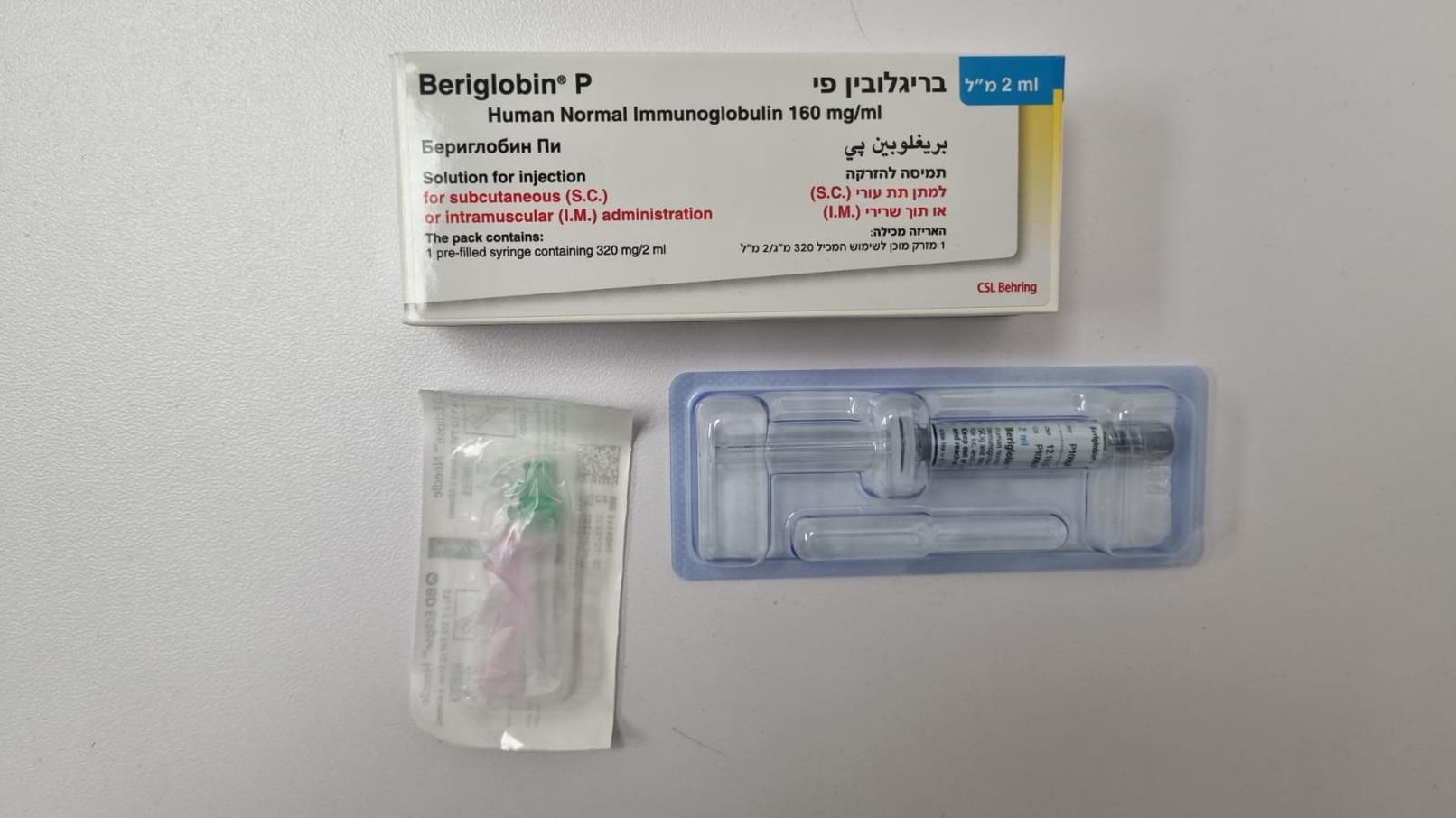Quest for the right Drug

בריגלובין פי. BERIGLOBIN P (IMMUNOGLOBULINS, NORMAL HUMAN)
תרופה במרשם
תרופה בסל
נרקוטיקה
ציטוטוקסיקה
צורת מתן:
תוך-שרירי, תת-עורי : I.M, S.C
צורת מינון:
תמיסה להזרקה : SOLUTION FOR INJECTION
עלון לרופא
מינוניםPosology התוויות
Indications תופעות לוואי
Adverse reactions התוויות נגד
Contraindications אינטראקציות
Interactions מינון יתר
Overdose הריון/הנקה
Pregnancy & Lactation אוכלוסיות מיוחדות
Special populations תכונות פרמקולוגיות
Pharmacological properties מידע רוקחי
Pharmaceutical particulars אזהרת שימוש
Special Warning עלון לרופא
Physicians Leaflet
Adverse reactions : תופעות לוואי
4.8 Undesirable effects Summary of the safety profile Adverse reactions such as chills, headache, dizziness, pyrexia, vomiting, hypersensitivity, nausea, arthralgia, hypotension and moderate low back pain may occur occasionally. Rarely human normal immunoglobulins may cause a sudden blood pressure decrease and, in isolated cases, anaphylactic shock, even when the patient has shown no hypersensitivity to previous administration. Local reactions at infusion sites: swelling, pain, erythema, induration, warmth, itching, bruising and rash, may frequently occur. For information on infectious disease risk see section 4.4. subheading “Transmissible agents”. Tabulated list of adverse reactions Adverse reactions have been collected from clinical studies and post-marketing experience. The table presented below is according to the MedDRA system organ classification (SOC and Preferred Term Level). Frequencies have been evaluated according to the following convention: Very common (≥1/10); common (≥1/100 to <1/10); uncommon (≥1/1,000 to <1/100); rare (≥1/10,000 to <1/1,000); very rare (<1/10,000), not known (cannot be estimated from the available data). A frequency category has been applied to adverse reactions observed in clinical trials. However for adverse reactions received from post-marketing experience, it is not always possible to reliably estimate frequency since reporting is voluntary and from a population of an uncertain size. For these reactions ‘not known’ has been assigned. Frequency of Adverse Reactions (ADRs) with Beriglobin P MedDRA System Adverse Reaction Frequency Organ Class s.c. i.m. (SOC) administration administration Immune system Hypersensitivity Common‡ Not known disorders (including blood pressure decrease) Anaphylactic Not known Not known shock/anaphylactic reactions (including dyspnoea, skin reaction) Nervous system Headache Common‡ Common‡ Syncope, dizziness Common‡ Not known Cardiac disorders Cardiovascular disorder¶ Not known Not known Vascular disorders Thromboembolism Not known (---) (including myocardial infarction, ischaemic stroke, deep venous thrombosis and pulmonary embolism) ^ Respiratory, Bronchospasm Common‡ Not known thoracic and mediastinal disorders Gastrointestinal Nausea, vomiting Not known Not known disorders Skin and Rash Common‡ Not known subcutaneous tissue disorders Musculoskeletal Back pain§ Common‡ Not known and connecitve tissue disorders General disorders Injections site pain§ Very common Very common and administration Injection site swelling, Very common Not known site conditions erythema, induration, warmth, pruritus, bruising, rash§ Injection site urticaria† (---) Not known Pyrexia Common‡ Common‡ Chills, malaise Common‡ Not known Arthralgia Not known Not known ‡ Reported in single cases from clinical study. ¶ Cardiovascular disorder particularly if the product has been inadvertently injected intravascularly. ^ Thromboembolism (including myocardial infarction, ischaemic stroke, deep venous thrombosis and pulmonary embolism) has been observed in association with s.c. substitution therapy only. § In a clinical study with s.c. administration frequency of local reactions at the injection site (including pain, swelling, erythema, warmth, pruritus, bruising, rash) declined very rapidly with the first ten infusions, when patients became used to the s.c. form of treatment. † Injection site urticaria has been observed with i.m. administration only. Description of selected adverse reactions Injection site urticaria has been observed with i.m. administration only. Thromboembolism (including myocardial infarction, ischaemic stroke, deep venous thrombosis and pulmonary embolism) has been observed in association with s.c. substitution therapy only. Paediatric population Frequency, type and severity of adverse reactions in children are expected to be the same as in adults. Reporting of suspected adverse reactions Reporting suspected adverse reactions after authorisation of the medicinal product is important. It allows continued monitoring of the benefit/risk balance of the medicinal product. Any suspected adverse events should be reported to the Ministry of Health according to the National Regulation by using an online form https://sideeffects.health.gov.il and emailed to the Registration Holder’s Patient Safety Unit at: PV-IL@cslbehring.com

פרטי מסגרת הכללה בסל
התרופה תינתן לטיפול במקרים האלה: א. חסר חיסוני ראשוני (חולים עם פגיעה ראשונית בייצור נוגדנים כגון אגמגלובולינמיה או היפוגמגלובוילינמיה, ITP (Idiopathic thrombocytopenic purpura)); ב. חסר חיסוני ספציפי, מניעה או טיפול בחצבת, הפטיטיס A ויראלית; ג. CIDP – Chronic inflammatory demyelineating polyneuropathy; ד.טיפול בחולי לוקמיה מסוג CLL הסובלים מהיפוגלמגלובולינמיה משנית חמורה וזיהומים חוזרים.
שימוש לפי פנקס קופ''ח כללית 1994
Primary immunodeficiency (patients with primary defective antibody synthesis such as agammaglobulinemia or hypogammaglobulinemia, idiopathic thrombocytopenic purpura (ITP)
תאריך הכללה מקורי בסל
01/01/1995
הגבלות
תרופה מוגבלת לשימוש בבתי חולים או אשפוז יום
מידע נוסף
